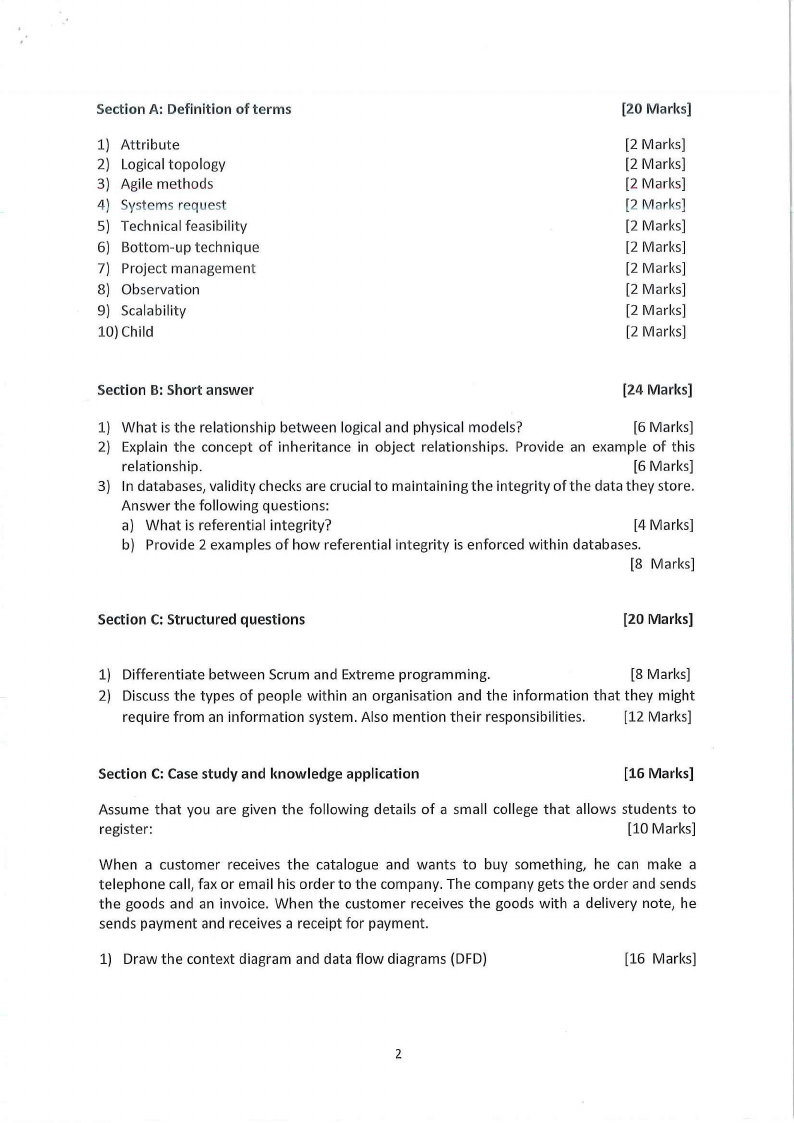 |
SAD621S - SYSTEMS ANALYSIS AND DESIGN - 2ND OPP - JAN 2024 |
 |
1 Page 1 |
▲back to top |

n Am I BI A u n IVER s ITY
OF SCIEnCE Ano TECHnOLOGY
FACULTYOF COMPUTING AND INFORMATICS
DEPARTMENTOF INFORMATICS
QUALIFICATIONS:Bachelor of Informatics
QUALIFICATION CODE: 07BAIF
LEVEL:6
COURSECODE: SAD621S
COURSE: Systems Analysis and Design
DATE: January 2024
SESSION:1
DURATION: 2 Hours
MARl(S: 80
SUPPLEMENTARY/SECONDOPPORTUNITYEXAMINATION QUESTION PAPER
EXAMINERS:
Mr Gabriel Nhinda
MODERATOR(S):
Prof Samuel Akinsola
THIS EXAMINATION PAPERCONSISTSOF 2 PAGES
(INCLUDING THIS FRONT PAGE)
INSTRUCTIONSFORTHE CANDIDATE
1. Answer all questions.
2. When writing, consider the following: The style should be to inform rather than
impress.
3. Information should be brief and accurate.
4. Please ensure that your writing is legible, neat and presentable.
 |
2 Page 2 |
▲back to top |

Section A: Definition of terms
1) Attribute
2) Logical topology
3) Agile methods
4) Systems request
5) Technical feasibility
6) Bottom-up technique
7) Project management
8) Observation
9) Scalability
10) Child
[20 Marks]
[2 Marks]
(2 Marks]
[2 Marks]
(2 Marks]
(2 Marks]
(2 Marks]
(2 Marks]
(2 Marks]
(2 Marks]
(2 Marks]
Section B: Short answer
(24 Marks]
1) What is the relationship between logical and physical models?
(6 Marks]
2) Explain the concept of inheritance in object relationships. Provide an example of this
relationship.
(6 Marks]
3) In databases, validity checks are crucial to maintaining the integrity of the data they store.
Answer the following questions:
a) What is referential integrity?
(4 Marks]
b) Provide 2 examples of how referential integrity is enforced within databases.
[8 Marks]
Section C: Structured questions
[20 Marks]
1) Differentiate between Scrum and Extreme programming.
[8 Marks]
2) Discuss the types of people within an organisation and the information that they might
require from an information system. Also mention their responsibilities.
(12 Marks]
Section C: Case study and knowledge application
[16 Marks]
Assume that you are given the following details of a small college that allows students to
register:
[10 Marks]
When a customer receives the catalogue and wants to buy something, he can make a
telephone call, fax or email his order to the company. The company gets the order and sends
the goods and an invoice. When the customer receives the goods with a delivery note, he
sends payment and receives a receipt for payment.
1) Draw the context diagram and data flow diagrams (DFD)
[16 Marks]
2





